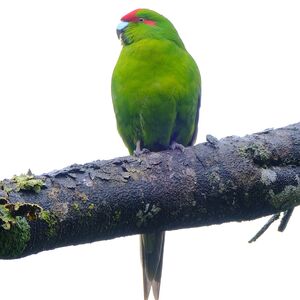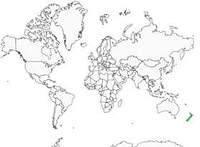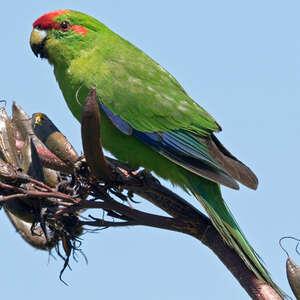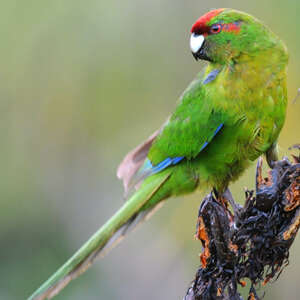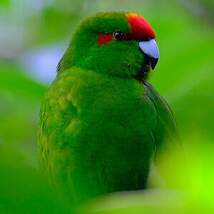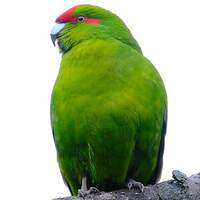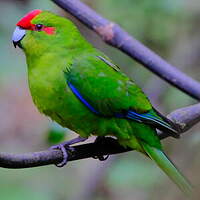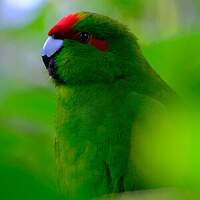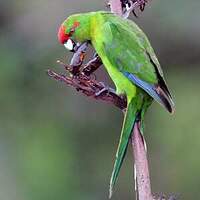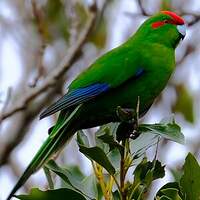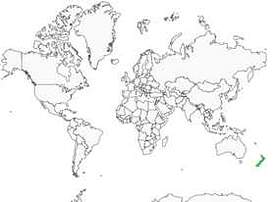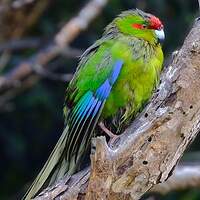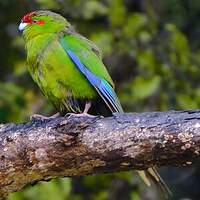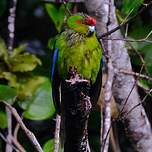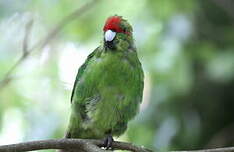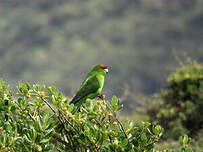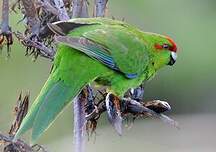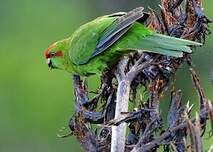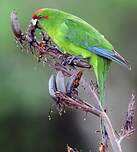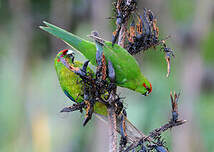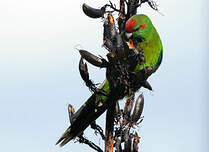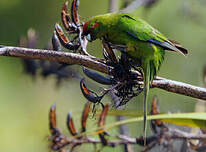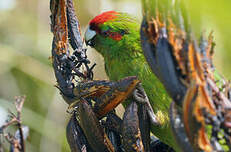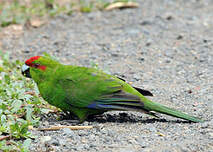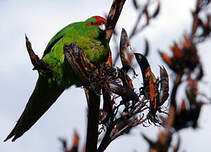Red-crowned Parakeet
Cyanoramphus novaezelandiae - Perruche de Sparrman
Identification
The Red-crowned Parakeet resembles the Golden-headed Parakeet with which it coexists in several sites. It differs by the lack of yellow on the forehead, replaced by a narrow red band between the beak and the top of the head. This red band does not touch the eyes. Generally, it is a darker green bird above than below and its wings are partially bluish. As in its congener, the sides of the rump are marked with crimson.
Subspecific information 4 subspecies
- Cyanoramphus novaezelandiae novaezelandiae (New Zealand and nearby islands, Auckland and Stewart Is.)
- Cyanoramphus novaezelandiae cyanurus (Kermadec Is.)
- Cyanoramphus novaezelandiae chathamensis (Chatham I.)
- Cyanoramphus novaezelandiae erythrotis ()
Foreign names
- Perruche de Sparrman,
- Perico maorí cabecirrojo,
- periquito-de-coroa-vermelha,
- Ziegensittich,
- piroshomlokú kecskepapagáj,
- Roodvoorhoofdkakariki,
- Parrocchetto fronterossa,
- rödpannad parakit,
- Rødkroneparakitt,
- kakariki červenočelý,
- kakariki rudočelý,
- Gedeparakit,
- uudenseelanninviherkaija,
- cotorra front-roja,
- modrolotka czerwonoczelna,
- Краснолобый прыгающий попугай,
- アオハシインコ,
- 红额鹦鹉,
- rödpannad parakit,
- 紅額鸚鵡,
Voice song and call
Habitat
Behaviour character trait
Couples of Red-crowned Parakeets remain together throughout the year. It is not easy to observe them in the forest, because they mostly stay in the canopy and their cries are usually what allows them to be spotted. Frequent movements are observed, with the birds travelling from an island to the continent or vice versa. However, these are not true migrations, but rather the erratic movement of birds looking for food.
Flight
Dietfeeding habits
The diet of the Red-crowned Parakeet is mainly vegetal, consisting of flowers, fruits and seeds. Additionally, the species also consumes honey and a few invertebrates. On the Kermadec Islands, this species also feeds on marine molluscs such as Scutellastra kermadecensis collected from marine wracks.
Reproduction nesting
The Red-crowned Parakeet is cavity-nesting, with eggs able to be placed in a variety of cavities (hollow trees, rock crevices, burrows, etc.). Egg-laying usually starts in October. Composed of 5 to 9 eggs (sometimes only 2, other times 10), the nest is incubated for about 3 weeks by the female alone. The young remain in the nest for 5 to 6 weeks, with the female providing most of their food. The male can also feed them, but usually does so through the female.
Geographic range
The Red-crowned Parakeet is endemic to New Zealand. Once widespread throughout the archipelago, it has almost disappeared from the South Island due to predation and deforestation. It still persists in the North Island's centre and remains commonplace on Stewart Island. It also occupies many small islands, either naturally (Little Barrier, Auckland, etc.) or after having been introduced (e.g. Tiritiri Matangi).
Four subspecies are generally accepted, with the forms cooki (Norfolk Island) and saisetti (New Caledonia) now considered full species in their own right.
Threats - protection
Sources of information
- IOC World Bird List (v15.1), Gill, F and D Donsker (Eds). 2025-12-07.
- Parrots, Tony Juniper
- The hand guide to the birds of New Zealand, Robertson Hugh et Heather Barrie
- Vol. 4 - Handbook of the Birds of the World, Josep del Hoyo-Andrew Elliott-Jordi Sargatal
- xeno-canto, Sharing bird sounds from around the world,
- Wikipedia - Scutellastra kermadecensis,
Other sources of interest
 Specification sheet created on
30/07/2023 by Georges Olioso
Specification sheet created on
30/07/2023 by Georges OliosoTranslation by AI Oiseaux.net
© 1996-2025 Oiseaux.net
- Accipitriformes
- Aegotheliformes
- Anseriformes
- Apodiformes
- Apterygiformes
- Bucerotiformes
- Caprimulgiformes
- Cariamiformes
- Casuariiformes
- Charadriiformes
- Ciconiiformes
- Coliiformes
- Columbiformes
- Coraciiformes
- Cuculiformes
- Eurypygiformes
- Falconiformes
- Galliformes
- Gaviiformes
- Gruiformes
- Leptosomiformes
- Mesitornithiformes
- Musophagiformes
- Nyctibiiformes
- Opisthocomiformes
- Otidiformes
- Passeriformes
- Pelecaniformes
- Phaethontiformes
- Phoenicopteriformes
- Piciformes
- Podargiformes
- Podicipediformes
- Procellariiformes
- Psittaciformes
- Pterocliformes
- Rheiformes
- Sphenisciformes
- Steatornithiformes
- Strigiformes
- Struthioniformes
- Suliformes
- Tinamiformes
- Trogoniformes

